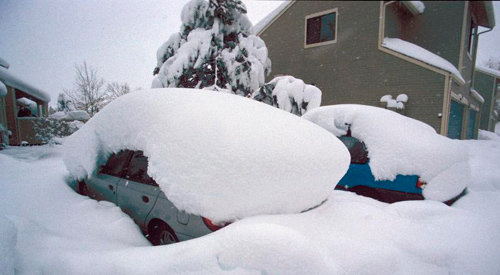Understanding the weather: An investment that pays off
From the President's Desk
Oct 4, 2012 - by Staff
Oct 4, 2012 - by Staff
Thomas Bogdan • October 4, 2012 | You never know what the weather is about to deliver. Who would have expected the unusual events of the last few months: the warmest spring on record, early-season tornado outbreaks across much of the nation’s midsection, the intense thunderstorms that knocked out power to millions in the Washington, D.C., area, the summer drought that sucked moisture from our croplands, and the disruption brought by a hurricane to a major political convention?

Thomas Bogdan, president of the University Corporation for Atmospheric Research. (©UCAR. Photo by Carlye Calvin.)
The United States faces more varied weather risks than most nations on Earth, but we also have uniquely strong capabilities to confront these risks. Thanks to decades of research conducted by government agencies, universities, and the private weather industry, we have become increasingly expert at forecasting major weather threats as much as several days in advance. But it remains highly challenging to predict longer-term trends, and we need to continue to support research to better understand those atmospheric events that affect so many facets of our lives and the economy.
According to NOAA, weather disasters in the United States wreaked an estimated toll of $52 billion last year, including 14 events that each cost more than $1 billion. While storms such as hurricanes and tornadoes may grab the headlines, it is often the more slow-moving atmospheric events, such as growing heat and dryness, that prove especially damaging. Even everyday weather, both favorable and damaging, is estimated to affect our economy by $485 billion yearly. And many weather impacts may be aggravated in a changing climate.
The good news is that research universities, working with private firms and national labs, are making headway in this important area. Over the last several decades, improvements in computer modeling—many of them conceived by university-based scientists—have made five-day forecasts as accurate as three-day forecasts used to be. Now researchers, while continuing to fine-tune those forecasts, are working on ways to improve projections over time periods of several weeks to several months. As covered in AtmosNews earlier this year, a major field study of the Madden-Julian Oscillation, which affects weather in many parts of the globe, could yield insights that improve seasonal prediction (see Between weather and climate).
What kind of benefits might we expect from such work? Thanks to better understanding of far-flung atmospheric patterns and the interconnections between oceans and air, our farmers will eventually get firmer projections on what the weather will be like in the coming growing season. Truckers will be able to anticipate, with far more detail than today, what the coming fall and winter will herald in terms of the likelihood of winter storms and snowpacked roads. Emergency managers look to a day when they can begin preparations weeks in advance if it appears that conditions are right for a weather disaster.

Snowstorms can paralyze entire regions for days on end. (©UCAR. Photo by Bob Henson.)
Such longer-term predictions will be critical to the continued vitality of the U.S. economy. When utility crews, snowplow drivers, and other emergency responders are able to mobilize far in advance, they greatly mitigate the effects of even a devastating storm on the smooth functioning of our society. What if the June 29 derecho—the powerful thunderstorm complex and its damaging winds that swept from the Midwest to the mid-Atlantic in a matter of hours—could have been anticipated several days ahead of time? Could such advance notice have helped teams of emergency workers avert the worst impacts of the storms on power lines and cellular networks?
In order to achieve such a goal, we need to maintain our investment in our nation’s weather research. In the vanguard are researchers at universities and federal labs who work with the $2 billion private weather service industry. The services by private companies, and the forecasts generated by the National Weather Service, are eagerly consumed by Americans who now use more than 300 billion state-of-the-art forecasts annually that are transmitted to our TVs, smartphones, laptops, and radios.
We will never fully weatherproof our society. Our atmosphere is far too chaotic for that. But just as researchers at our universities and federal laboratories have made it possible to chart the likely path of a hurricane several days in advance or alert vulnerable residents precious minutes before a tornado strikes, they are now working toward a new generation of outlooks that will help us prepare for disruptive weather patterns even further ahead. The public and private dollars invested in this endeavor have been, and will continue to be, repaid many times over.